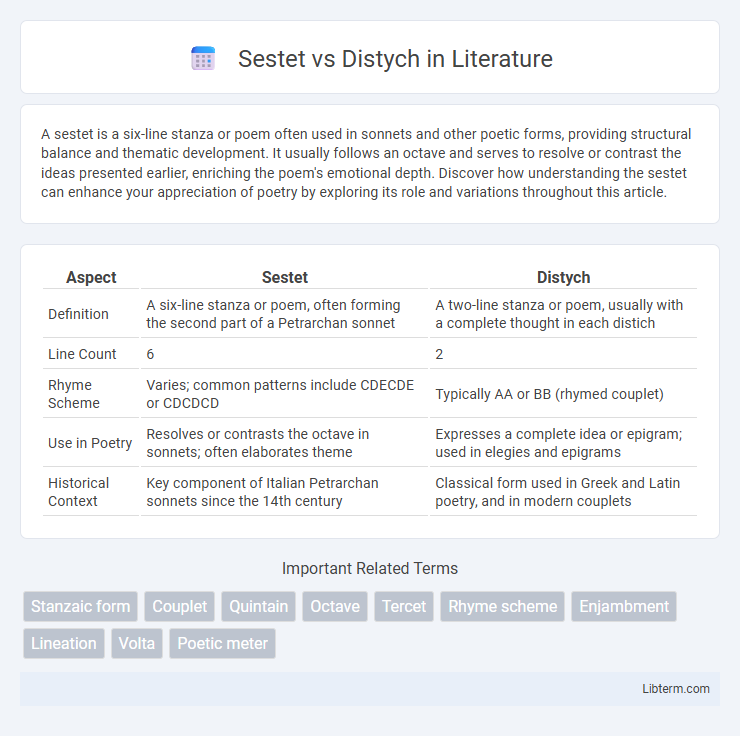A sestet is a six-line stanza or poem often used in sonnets and other poetic forms, providing structural balance and thematic development. It usually follows an octave and serves to resolve or contrast the ideas presented earlier, enriching the poem's emotional depth. Discover how understanding the sestet can enhance your appreciation of poetry by exploring its role and variations throughout this article.
Table of Comparison
| Aspect | Sestet | Distych |
|---|---|---|
| Definition | A six-line stanza or poem, often forming the second part of a Petrarchan sonnet | A two-line stanza or poem, usually with a complete thought in each distich |
| Line Count | 6 | 2 |
| Rhyme Scheme | Varies; common patterns include CDECDE or CDCDCD | Typically AA or BB (rhymed couplet) |
| Use in Poetry | Resolves or contrasts the octave in sonnets; often elaborates theme | Expresses a complete idea or epigram; used in elegies and epigrams |
| Historical Context | Key component of Italian Petrarchan sonnets since the 14th century | Classical form used in Greek and Latin poetry, and in modern couplets |
Introduction to Sestet and Distych
A sestet is a six-line stanza often found in sonnets, especially the Italian or Petrarchan sonnet, characterized by a specific rhyme scheme and thematic resolution. A distych, or couplet, consists of two lines that usually rhyme and form a complete thought or idea, commonly seen in classical and modern poetry. Understanding the structural and thematic differences between sestets and distychs helps poets and readers appreciate variations in poetic form and expression.
Definition of Sestet
The sestet is a six-line stanza or poem segment that often concludes an Italian sonnet, serving as a pivotal resolution to the octave's problem. It features various rhyme schemes, such as CDECDE or CDCDCD, contributing to its musicality and emphasis on thematic closure. Unlike a distich, which consists of only two lines typically forming a couplet or epigram, the sestet provides a more extended and complex structure for developing ideas or emotions.
Definition of Distych
A distych is a pair of lines forming a complete thought, often used as a standalone couplet or the closing portion of a poem, typically emphasizing brevity and impact. Sestet, by contrast, is a six-line stanza or the last six lines of a sonnet, providing extended development or resolution. Distichs are characterized by their concise expression and frequent appearance in classical and modern poetry as epigrammatic or reflective verses.
Structural Differences
A sestet consists of six lines forming the second part of an Italian sonnet, often following an octave, while a distich comprises only two lines that typically function as a complete thought or epigram. The sestet's structure allows for more complex rhyme schemes such as cdecde or cdcdcd, whereas the distich usually employs a single rhyme or rhymed couplet pattern. These fundamental differences in line count and rhyme design distinguish the sestet's extended thematic development from the distich's concise and punchy expression.
Historical Origins and Usage
The sestet, originating from classical Italian sonnets, traditionally comprises six lines forming the poem's resolution or counterpoint, particularly in Petrarchan sonnets. The distich, rooted in ancient Greek and Latin poetry, typically consists of two-line units used for epigrams, couplets, and elegiac couplets, serving as concise expressions or thematic pairs. Both forms have evolved, with the sestet maintaining prominence in structured sonnets and the distich widely employed in varied poetic contexts for brevity and emphasis.
Sestet vs Distych in Famous Poetry
Sestets and distichs serve distinct roles in famous poetry, with sestets consisting of six lines often forming the second part of an Italian sonnet, exemplified in works by Petrarch and Dante. Distichs, or couplets, are two-line stanzas commonly used for epigrams and emphasize brevity and impact, as seen in the poetry of Alexander Pope and W.B. Yeats. The structural difference influences thematic development, with sestets providing expansive elaboration while distichs deliver concise, pointed expression.
Thematic Functions
Sestets, consisting of six lines, often provide a resolution or a thematic deepening in poetic structures, allowing exploration of complex emotions or ideas such as contemplation and closure. Distichs, composed of two lines, typically highlight contrast or complementarity, emphasizing succinct thematic expressions like duality or moral reflection. Thematic functions of sestets tend to develop nuanced argumentation or emotional resonance, whereas distichs deliver sharp, impactful insights or conclusions.
Common Forms and Variations
Sestets commonly appear as six-line stanzas in forms like the Petrarchan sonnet, characterized by rhyme schemes such as CDECDE or CDCDCD, while distichs are two-line stanzas or couplets typically featuring rhymed or unrhymed pairs, often used as epigrams or in elegiac couplets. Variations of sestets include enclosed rhyme patterns and meter shifts to enhance thematic depth, whereas distichs may vary between heroic couplets in iambic pentameter or simple rhythmic pairs for concise expression. Both forms serve distinct poetic functions, with sestets allowing expanded thematic development and distichs emphasizing brevity and wit.
Writing Tips for Sestet and Distych
Sestets and distichs represent distinct poetic forms, with sestets containing six lines and distichs consisting of two lines. For sestet writing, emphasize a coherent thematic progression and varied rhyme schemes like ABABCC to enhance rhythmic complexity. Distichs demand precision and impact, encouraging concise word choice and a balanced or contrasting couplet structure to deliver potent, memorable messages.
Choosing Between Sestet and Distych
Choosing between a sestet and a distych depends on the desired poetic structure and thematic complexity. A sestet, comprising six lines, offers more space for developing intricate ideas or emotions, often used to conclude sonnets with a rich, reflective tone. In contrast, a distych, consisting of two lines, provides brevity and impact, ideal for epigrams or sharp, condensed expressions.
Sestet Infographic

 libterm.com
libterm.com